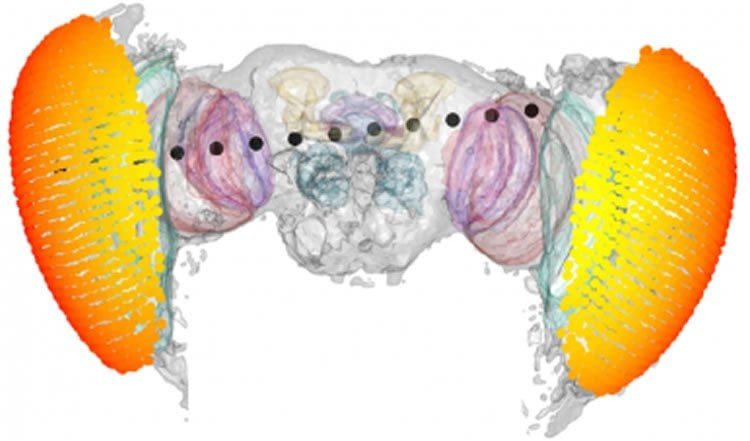University of Queensland researchers have shown, like humans, fruit flies may be self-aware of their actions.
Scientists at UQ’s Queensland Brain Institute placed tethered Drosophila melanogaster fruit flies in front of a digital display, on an air-supported ball, while recording multiple parts of their brain simultaneously.
QBI’s Associate Professor Bruno van Swinderen said the experiment was a virtual reality scenario where the flies had the ability to control either the position of a visual stimulus (a dark bar), or were shown replayed movies of the stimulus they were not able to control.
“We found that when the fly is in control there is an increase in communication between brain regions, compared to when they are just responding to the very same visual stimuli replayed to them,” he said.
Dr van Swinderen said it was known from human research that different parts of the brain needed to work together for attention and perception to occur effectively.
“Looking at only one part of the brain at a time may be less revealing about attention, because the whole brain is likely to be involved,” he said.
“It’s really interesting that humans and flies share the ability to focus and have attention.
“The difference is that we have around 100 billion neurons, and they only have 100,000 to do pretty much the same – focus on one thing at a time and select the best course of action.”
The experiments showed that each fly is an individual with its own strengths, weaknesses and preferences.
“There were actually some star performers that immediately understood whether they were in control or not, and some never seemed to know the difference,” Associate Professor van Swinderen said.

“Across our research, there is always individuality between all of the animals. Tthey all behave differently.”
One important conclusion from this research is that understanding how attention works in the brain may might require studies of how different brain regions interact, rather than only looking at one brain region at a time.
Ms Leonie Kirszenblat, a PhD student who performed the work with postdoctoral researchers Dr Angelique Paulk and Dr Yanqiong Zhou, said the research had important implications on how to study attention in animal models.
“Traditionally, in animal models such as Drosophila, the tendency among researchers has been to try to find single brain regions responsible for different functions,” Ms Kirszenblat said.
“However, we now know that to best understand how animals attend to and respond to their environment, we need to devise methods allowing us to manipulate and observe multiple brain regions simultaneously,” she said.
“This is now possible in Drosophila, but still hard to do in many other animals.”
Source: Darius Koreis – University of Queensland
Image Credit: The image is credited to the researchers
Original Research: Abstract for “Closed-Loop Behavioral Control Increases Coherence in the Fly Brain” by Angelique C. Paulk, Leonie Kirszenblat, Yanqiong Zhou, and Bruno van Swinderen in Journal of Neuroscience. Published online July 15 2015 doi:10.1523/JNEUROSCI.0691-15.2015
Abstract
Closed-Loop Behavioral Control Increases Coherence in the Fly Brain
A crucial function of the brain is to be able to distinguish whether or not changes in the environment are caused by one’s own actions. Even the smallest brains appear to be capable of making this distinction, as has been shown by closed-loop behavioral experiments in flies controlling visual stimuli in virtual reality paradigms. We questioned whether activity in the fruit fly brain is different during such closed-loop behavior, compared with passive viewing of a stimulus. To address this question, we used a procedure to record local field potential (LFP) activity across the fly brain while flies were controlling a virtual object through their movement on an air-supported ball. The virtual object was flickered at a precise frequency (7 Hz), creating a frequency tag that allowed us to track brain responses to the object while animals were behaving. Following experiments under closed-loop control, we replayed the same stimulus to the fly in open loop, such that it could no longer control the stimulus. We found identical receptive fields and similar strength of frequency tags across the brain for the virtual object under closed loop and replay. However, when comparing central versus peripheral brain regions, we found that brain responses were differentially modulated depending on whether flies were in control or not. Additionally, coherence of LFP activity in the brain increased when flies were in control, compared with replay, even if motor behavior was similar. This suggests that processes associated with closed-loop control promote temporal coordination in the insect brain.
SIGNIFICANCE STATEMENT We show that closed-loop control of a visual stimulus promotes temporal coordination across the Drosophila brain, compared with open-loop replay of the same visual sequences. This is significant because it suggests that, to understand goal-directed behavior or visual attention in flies, it may be most informative to sample neural activity from multiple regions across the brain simultaneously, and to examine temporal relationships (e.g., coherence) between these regions.
“Closed-Loop Behavioral Control Increases Coherence in the Fly Brain” by Angelique C. Paulk, Leonie Kirszenblat, Yanqiong Zhou, and Bruno van Swinderen in Journal of Neuroscience. Published online July 15 2015 doi:10.1523/JNEUROSCI.0691-15.2015







